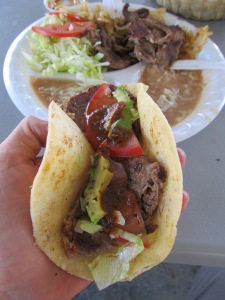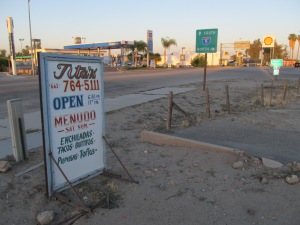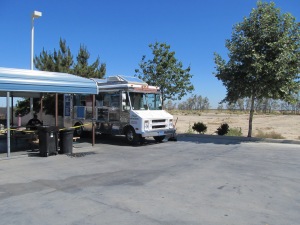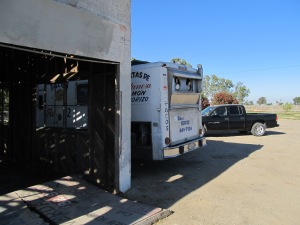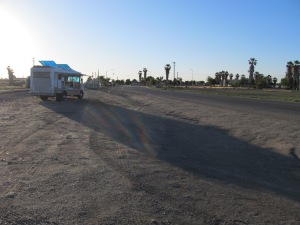Even though Urban Dictionary defines ‘lonchero’ as “lunch time consensual sex between two Gay Males,” it more commonly means lunch or taco truck.
Like Denny’s and credit card debt, loncheros are everywhere, from Texas to Seattle to North Carolina’s Research Triangle. In Los Angeles they’re so numerous that they even have their own association, La Asociación de Loncheros L.A. Familia Unida de California, to advocate for themselves as “an asset to the economic and socio-cultural landscape of Los Angeles” whose owners “contribute to the well-being of the communities they operate in,” and to protect their business interests. Another community forum in LA keeps lunch trucks up to date on threats and relevant developments.
I’m devoted to taco trucks. I eat at them wherever I travel, and I’m rarely disappointed. The loncheros I find most interesting, though, are those serving rural areas. Out there amid sprawling farm fields, near little but train tracks and irrigation ditches, you can’t help but wonder how these loncheros stay solvent. Where does their electricity come from? How often do customers arrive? And is it frequently enough to keep the meat fresh and produce circulating? While passing through California’s rural San Joaquin Valley recently, I ate a bunch of tacos.
You might have driven through the San Joaquin en route to somewhere else: going from LA to San Francisco, maybe, or from Oregon down toward Interstate 10. It’s that hot flat place bisected by I-5 and Highway 99 that often smells like manure and onion soup. You might not have known it had a name and just called it “that shithole.”
Sandwiched between the Sierra Nevada and Coast Range, California’s great rural core stretches over four hundred miles north and south and around fifty miles across, forming one of the world’s most productive agricultural regions. With nearly 300 commercial crops, everything from almonds to olives, tomatoes to rice, the Central Valley produces 25% of all table food in the United States and houses the world’s largest cotton farm, five of the country’s top ten agricultural counties, and the birthplace of the raisin.
The San Joaquin is the drier southern half of the Central Valley. Scorching in summer, foggy in winter, it’s flat as a board and consistently ridiculed for being featureless, backwards and boring―and understandably so. This is a land of pickups and truck-stops, ample fodder for meth references and redneck jokes.
For reasons too complicated and confusing to bore you with here, I love the place. To me, it’s the ugly dog that you can’t help petting. Here are some of the loncheros of the rural San Joaquin. I like that phrase because it sounds like a western.
1) Chelitas Tacos
“Chelitas Tacos,” said the sign on the passenger door, “by Consuelo Rodriguez.” Set beside a McDonald’s, across the street from the Auto Zone, this lunch truck in the town of Lamont was parked on the side of the Rancho Viejo Carnicería lot.
I asked for two tacos and a side of refried beans. The cook handed me a plate covered with grilled onions and hunks of beef. Hot tortillas came in a basket, their heat locked in with a towel even though it was over ninety degrees out. When some time passed, Consuelo threw open the window screen and said, “You need more tortillas?” I said no thank you, I was okay. She brought three more anyway, in another basket.
Three tables sit under a metal awning, which sit in the shade of some scraggly pines. Chelitas likely gets its meat from the Rancho Viejo Carnicería. It definitely got its electricity from there: two yellow cables ran through a hole in their nonfunctioning fountain drink system and plugged into the side of the meat market. It was a symbiotic relationship. At one point, a carnicería clerk came out in his apron and had the cook make change from a $20 dollar bill.
The truck’s menu was unusually diverse: tostadas, tostilocos, huaraches, molitas, quesadillas, sopes, posole, flautas, tacos, nachos, burritos and a hot dog plate. No prices were listed, which explains my shock when I pulled out my wallet to pay and the cook said, “Setenta.” Seven dollars? Since I ordered one carne asada, and one pastor taco, plus beans, I only expected to pay around $4.50.
Did they sucker a gringo? Doubtful. The cook had taken my order while Consuelo was out, and because my Spanish is rusty and his English poor, he seemed to think I ordered the carne asada plate, which was fine. He delivered a feast.
As I ate, cars lined up at the McDonald’s drive through window. Car after car after car, slaves to the predictable blandness of frozen, pre-formed patty life. I salted my meat and doused it with salsa, and as much as I wanted to eat it all there, I took half of it home. It was a lot of meat.
2) Two Pupusarias
Tita’s Pupuseria wouldn’t sell me a pupusa without cheese. “Beans and pork, yes,” the clerk said. “Squash and cheese, yes. But not beans and squash. Cheese.”
I’d been polite when I first placed my order, explaining that I don’t eat much dairy, and that for various health reasons, I only wanted beans or beans in vegetables in my pupusa, no cheese. She said she couldn’t do that.
“But you can do pork and vegetables?” I said.
“Yes,” she said, staring at me through the window. “And beans and pork.” She stepped away from the window and returned with a large Ziploc bag full of grated cheese. “See? It’s all grated.” She held the bag out for me, kneading the heavy bottom as if to prove it was harmless. She pointed to something behind the counter that I couldn’t see, and said, “And that’s the meat.” I didn’t know how to respond. “How about a sopa?”
I said, “No thanks.” I come from a family with extreme heart problems, so I try not to eat fried food.
She said, “How about tacos?”
“I’m all taco’d out. I’m craving pupusa.”
“How about beans with tortilla on the side?”
I didn’t say this out loud, but beans with tortilla on the side sounded as appealing as eating cold refried beans straight from a can. I stared into her eyes. They offered no sign of diplomacy. “So you won’t sell me a pupusa at all, is what you’re saying?”
She nodded yes. “Sorry, mijo.”
I went across the street. There was another pupusa cart in the ARCO lot.
This was at a travel center on I-5, outside the town of Buttonwillow. A pupusa mini-explosion seemed to be sweeping through the small cluster of gas stations and motels from top to bottom, so a few hundred yards. There was Tita’s Pupuseria Salvadoran & Mexican Restaurant on the north end, next to Castro Tire & Truck Wash. There was Tita’s pupusa lonchero, in the potholed dirt lot beside the highway onramp. And there was Elsy’s Antojitos Centro Americanos on the opposite side of the street.
The two times I’d eaten at Tita’s, it was just a Mexican food cart. That was many years ago, and it might have even gone by a different name. But they served basic lonchero menu items – tacos, burritos, Jarritos – and had a really nice salsa bar on a foldout table and offered hand-roasted Serrano peppers. There were no pupusas.
The other time I ate here was at a lonchero in the E-Z Trip Food Store parking lot, across from Denny’s. Again, it was tasty but no frills. They made me a bean burrito with no cheese, no problem.
Elsy’s Antojitos Centro Americanos was so delicious that it made me grateful for Tita’s rejection.
Along with tacos, burritos and enchiladas, they sold pupusa for $2.75 a piece.
I stepped to the window without a moment’s wait and, despite my inclination to avoid meat that night, I ordered one with pork and beans, no cheese. The clerk didn’t even mention the cheese. She just wrote it on the ticket and took my money.
Parked on the north edge of the ARCO station, Elsy’s stood on the east side of the travel center, on the edge of a vast sandy lot, undeveloped and covered in native desert scrub, that stretched as far east as I could see.
A Hispanic man selling oranges and cherries parked his pickup truck on the street below the ARCO sign.
Eleven semis parked in a row next to the lunch truck, some for the night, others just resting momentarily.
Thirteen of us ate here, all men. “Excuse me,” one said while lowering himself on my bench. His friend waved a friendly hello as he took a seat at our table. There were four wooden picnic tables under the metal canopy, and for 8:30 at night, this place was packed.
While placing his order, one trucker said “Sinaloa” to the cook. It was the only word in his rapid fire sentences that I understood. A pickup pulled up, playing Norteño, and three men piled out. Three other men in Western shirts and jeans stood around a pickup, leaning against the red rim of the bed. Two wore cowboy hats. Behind them towered the familiar red and yellow McDonald’s sign, its colors cast against the crepuscular blue of night.
3) Tacos Mi Casita
In the town of Buttonwillow proper, on Lokern Road, this lonchero was parked in a decommissioned gas station. Had I not just eaten breakfast, I would have eaten here.
4) Ricos Tacos
When I arrived at Ricos Tacos, two men in uniform blues stood at the counter eating, covered in sweat.
Located on Mt. Whitney Avenue, outside the 3000-person town of Riverdale, this lonchero leads a lonely existence.
Mt. Whitney Ave isn’t a popular route to anywhere. Tourists don’t pass by. People heading to the Indian casino near Lemoore or up to Fresno take other routes. Customers seemed to be truckers, locals, farm hands and factory workers.
Ricos Tacos overlooked a dirt lot and sprawling green fields. Parked against the eroded eastern wall of the gutted Hancock Gasoline Market, there were no tables or places to sit. There was shade, though. You could park your car under the big tree and sit on your trunk or hood. The view was nice and the silence peaceful.
The tacos were great, too. Served on bright yellow corn tortillas and loaded with rich, juicy asada, Ricos garnished them with a thick sliver of lemon and radish slices, all for $1.25 a piece.
Riverdale is one of many small towns set amid the braided channels of the King’s River alluvial fan, southwest of Fresno. Because this area’s tiny rural towns are tied to the rich soils and high water table of the King’s River, they often grow grapes and have more large, shapely oaks than towns to the south and west, so I think of them all as a unit. A sense of isolation and insularity also permeates the area.
When you park at a condemned building, you have to make your own energy. Ricos draws part, or maybe all, of it juice from a generator mounted on the grill.
After I ate, I stepped to the front of the truck in search of a trash can. I found a gray plastic tub standing against the market wall, hidden by sumac. One side had cracked off like a broken tooth. Old paper plates and napkins filled it, covered with gravel and a fine gray powder looked like cement dust. When I snapped a photo from that position, a door on the back of the truck swung open, and the cook stepped out. He came right over and said, “You taking picture.”
I said Yes, I was, and explained that I liked write about places where I ate. He nodded and stared at my camera, still unsure. “I saw you taking pictures,” he said and pantomimed the process, understandably unnerved at my intentions. There was a sign in the front window announcing that the last food inspection certificate was available upon request. Maybe he was concerned about health inspections, maybe immigration.
I explained that I only wanted to post photos of his truck and food online. “Is that okay if I do?”
He said, “Sure, that’s okay.” He extended his hand to shake. “What’s your name?”
I told him it, first and last, as we shook. “What’s your name?”
“Orlando,” he said and went back inside to cook the food of the man who just pulled up in a maroon pickup.
5) San Joaquin, California
Another truck parked on Colorado Road, just before entering the town of San Joaquin. Set on the dirt shoulder flanking the train tracks beside a cotton field, it stood alone at 7:20pm, with no customers.
Oompa music played from inside it. Cars passed, no one stopped. Cool wind blew. Say what you will about this corner of California, but it was beautiful here, peaceful.





